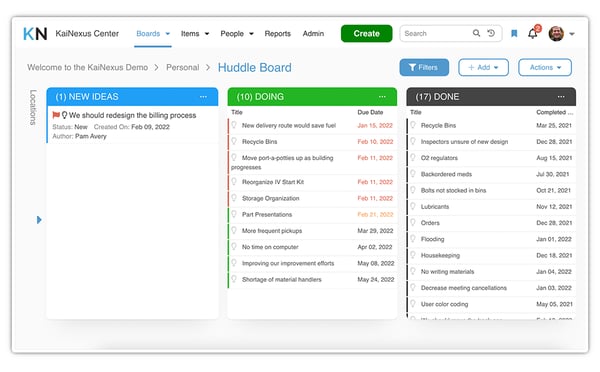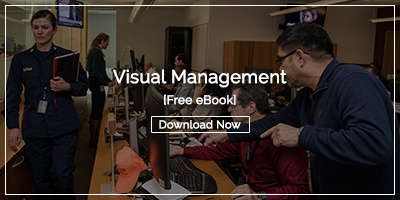 In sports, a huddle happens when the team gathers to strategize before a play. Huddles help everyone know their role in executing the plan or defending against the opposing team. The overall game plan is well known to the players in advance, so the huddle is quick and focused on what needs to happen right now.
In sports, a huddle happens when the team gathers to strategize before a play. Huddles help everyone know their role in executing the plan or defending against the opposing team. The overall game plan is well known to the players in advance, so the huddle is quick and focused on what needs to happen right now.
Huddles in Healthcare
In any setting, including healthcare organizations, huddles are short stand-up meetings, usually 10 to 15 minutes. They are typically held at the beginning of each day or shift in a clinical setting (or very early in the shift). The purpose is to create time and space for quick yet meaningful conversations to set the process improvement priorities for the day, close out completed projects, and focus on problem-solving.
Huddles usually cover the quick status of the day's current state, information from management to the team, and requests or updates from team members. There is also a focus on improvement, not just updates and announcements.
This type of daily management is what makes continuous improvement genuinely continuous. Without a structure for day-to-day management, it is difficult, if not impossible, to change the culture and elevate how team members integrate improvement into every aspect of their work days and thinking. While there are many ways to implement daily management, huddles are usually a significant component of daily management systems.
Visual Management with Huddle Boards
Huddle boards allow participants to visualize the progress of process improvements, ranging from minor improvements to larger projects. In addition, attendees can discuss open opportunities for positive change and work as one to remove any obstacles to improvement.
While there are limitless ways to structure a huddle board, most contain critical metrics and targets for improvement. For example, in a hospital, the number of falls might be tracked on a huddle board. In a physician's office, waiting time may be a crucial metric. The metrics help the team understand how their work affects the organization's strategic goals. The gap between current performance and the goal helps the team prioritize improvement activity to close that gap.
Some work teams use a Kanban Board, or multiple-column layout, with headings like To Do, Doing, and Done. Improvement opportunities are documented on cards that move from one column to the next as they progress toward completion.
Whatever layout an organization chooses, the content should be meaningful and actionable for those attending the huddle.
Advantages of Going Digital
While physical huddle boards hanging on the wall have been used by healthcare organizations for years, today, many organizations opt for electronic huddle boards for many compelling reasons.
Digital boards enable remote and traveling workers to engage in the huddle meeting. They are especially well-suited for teams with multiple shifts. With a digital board, collaboration does not require proximity.
For example, if you have a subject matter expert who doesn't work at the same time as your team, they can easily participate from home over a video meeting and still have the information they need at hand to be engaged.
Shifting away from physical boards is also advantageous for leaders who manage multiple teams. Of course, leaders should visit the physical workplace frequently, but with digital boards, it is possible to get the latest updates on improvement works without being physically present.
One drawback of physical huddle boards is that they are limited by space. It would be a complete mess if you kept all the completed projects on your board for even a year. Removing implemented opportunities from view limits their use as inspiration and instruction for future process improvements. This is not an issue with digital boards. Completed ideas can be stored forever, and team members can easily search to see what's been tried before.
It doesn't have to be all or nothing. We can use a hybrid strategy where a digital board (a large monitor or TV) can replace the bulletin board or whiteboard. This way, people who are physically huddling can still collaborate with those who are remote -- the best of both worlds.
We mentioned in the opening paragraph that the overall game plan in sports isn't discussed in the huddle, but it informs the decisions that come out of it. In a healthcare huddle, the same is true. Each daily improvement activity should be aligned with the strategic annual and long-term goals. When part of a comprehensive improvement platform, digital huddle boards can achieve strategic alignment by cascading goals from the organization level to the team level.
Essential Digital Huddle Board Features
If you implement a digital huddle board solution, ensure it has the following critical features to set your team up for success.
Flexible Layout
Since each organization and work team has different needs, the ability to configure your board is essential. If you've already found an arrangement with your physical board that works well, why reinvent the wheel when you can improve it?
Alerts and Notifications
Unfortunately, physical boards can't alert team members when a task is due or a new improvement opportunity has been submitted, but digital ones can. Look for a solution with email alerts and notifications that help keep improvement activities in mind throughout the day.
Long-Term Knowledge Retention and Search
Your digital huddle boards are a window into your organization's knowledge. They capture all improvement projects and any related images, documents, or other attachments. It should be easy for team members to dig into past projects to see what they should replicate or avoid.
Rotating Wallboards
It is appropriate that each team's huddle meeting be focused on process improvements that immediately impact them. However, the overall success of healthcare organizations depends on how all groups perform and how well they work together. Rotating wall boards is a great way to give each area insight into the improvement efforts of others. They serve as a real-time dashboard for the health of continuous improvement across the whole location or system.
Best Practices for Getting the Most Out of Huddle Meetings and Boards
Make Sure They Are Efficient
Daily huddle meetings should be strictly time controlled, driven by the board, and consistent. Discussions that always happen at the same time and with the same tools encourage attendance and active participation. If your huddle meetings drag on or lose focus on process improvement, they will become less valuable. A huddle is often used to "triage" an idea, with deeper investigation and problem-solving happening later.
If your huddle boards are digital, you can expect team members to have reviewed the current state of work-in-progress and come to the meeting prepared to participate knowledgeably based on the personalized updates and notifications they received overnight.
Assess Participation
Attendance is one thing, but developing a culture of improvement means ensuring that each person actively participates in positive change. Most groups will have a few people that tend to dominate any conversation, so it is helpful to have a facilitator to ensure the floor is shared. It helps to encourage the quieter members of your team to speak up, especially when their body language looks like they have something to say.
Elevate Problem-Solving and Avoid Placing Blame
The last thing you want is for your huddle meeting to become a gripe fest. It should be a safe place to discuss problems and challenges, but the focus should always be on solving process problems, not blaming people. The huddle board is excellent for turning attention back to pressing matters. Point to the process (and the broader value stream) instead of pointing fingers at others.
Calculate Impact and Celebrate Success
Understanding the impact of your team's improvement efforts is critical to sustaining enthusiasm and justifying any improvement expenses. The best software platforms for digital huddle boards also include tools to calculate the immediate and long-term impacts of improvements easily. Whether each win was a team effort or an individual who went above and beyond to achieve a goal, broadcast that success widely.
Huddle boards and meetings are prevalent in healthcare because they are ideally suited to dynamic workplaces with high-stakes responsibilities. Huddles allow each person to make a suggestion, raise a red flag, or congratulate a teammate on a job well done. Like any other approach to continuous improvement, huddle boards and meetings require attention, flexibility, and care, but they can help maximize the potential of every healthcare team.




Add a Comment